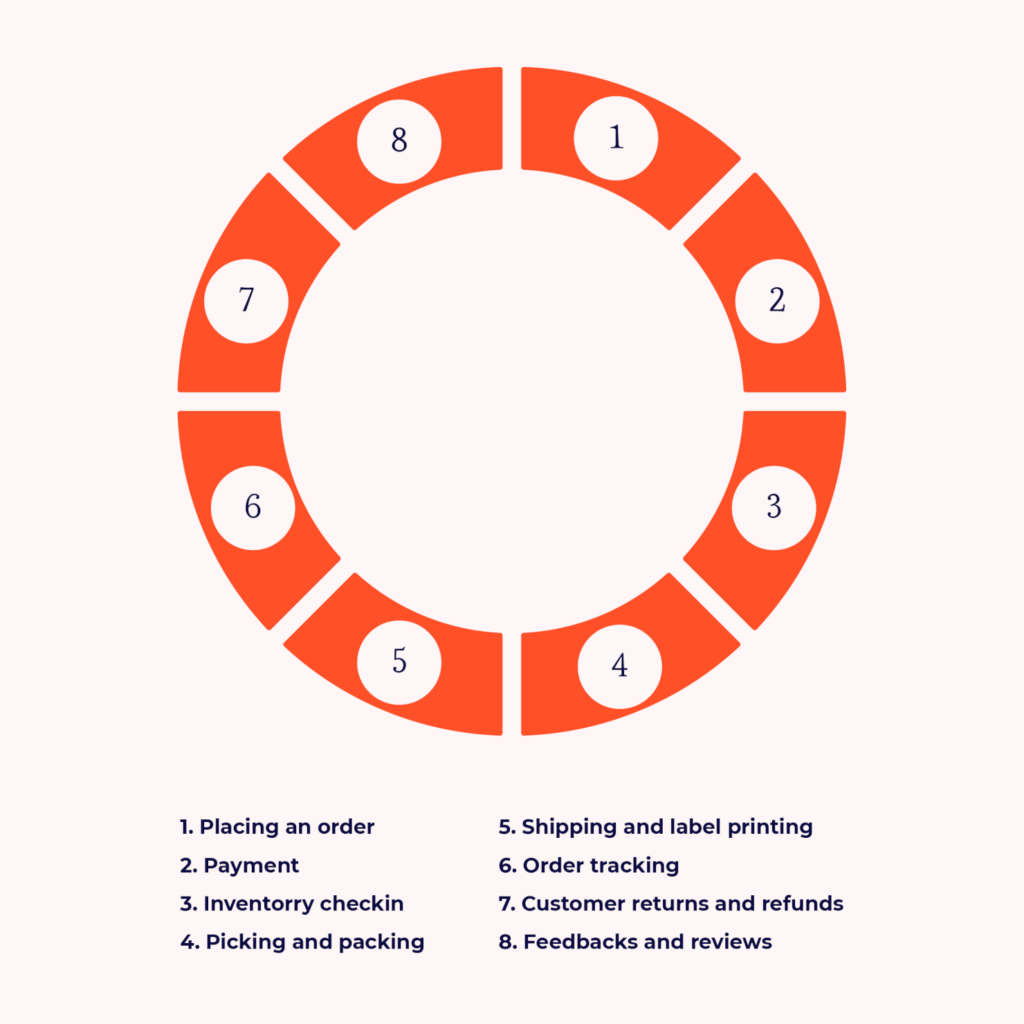Spreadsheet Missteps and Pen-Paper Blunders: 43% of ecommerce brands use outdated methods like spreadsheets, leading to late or missed orders. These errors cost sales and harm customer trust.
OMS: Your Order-Saving Superhero: An effective order management system streamlines tracking from order to delivery, automating and integrating tasks to enhance efficiency and customer satisfaction.
Right Fit? OMS Tailors to Your Needs: The right OMS centralizes operations for scalability, making it crucial for ecommerce growth, multi-channel sales, and those with complex fulfillment needs.
OMS Magic: Automate Your Order Odyssey: Automating workflows with an OMS reduces human error, integrates essential systems, and boosts fulfillment speed, proving invaluable for thriving businesses.
A Roadmap to Avoiding Order Chaos: Implementing an OMS helps you manage growth demands efficiently, preventing overselling and optimizing fulfillment, so you focus on business expansion.
If you haven’t already, now is the time to start thinking about an order management system (OMS) for your ecommerce brand.
In the US, 43% of ecommerce businesses still track inventory using spreadsheets or even pen and paper. It’s no surprise that 34% have shipped an order late—or not at all—due to inaccurate stock levels.
These mistakes create customer confusion, damage your reputation, and ultimately cost you sales.
Order management isn’t just about tracking orders—it touches every part of your business, from inventory management to picking and packing, shipping, returns, and even customer communication.
And while managing customer orders manually might work when you’re just starting out, things quickly become complex as you expand across multiple sales channels, marketplaces, and fulfillment locations.
Enter the order management system.
A good OMS keeps your orders organized, improves efficiency, and ensures a seamless customer experience—all while helping your business scale.
But with so many OMS solutions available, choosing the right one can feel overwhelming—especially if it’s your first time using one.
To help, we’ll break down what an OMS is, how it works, key features to look for, and how to choose the best one for your business.
What is an Order Management System?
An order management system (OMS) is any system that helps businesses track, manage, and fulfill orders from the moment a customer places an order to final delivery—and even returns.
At its simplest, an OMS can be a manual process using spreadsheets and shared folders.
When I first started selling online, I managed orders with Google Sheets and Drive, but it quickly became time-consuming and prone to human error. Keeping track of stock levels, updating customer details, and ensuring orders were shipped on time became a challenge.
That’s why most growing businesses invest in dedicated order management software.
A modern OMS automates order tracking, integrates with other essential systems (like CRM, supplier databases, and inventory management tools), and ensures seamless fulfillment—reducing errors and saving time.
In short, an OMS helps you stay organized, fulfill orders faster, and keep customers happy.
Who Needs an Order Management System?
If you’re handling more than a handful of orders a day, an order management system (OMS) can save you time, reduce mistakes, and help you scale. But not every business has the same needs.
Here’s who benefits most from an OMS:
- Ecommerce businesses selling on Shopify, Amazon, eBay, or their own website need a centralized system to keep orders and inventory levels in sync across all channels.
- Brick-and-mortar retailers expanding online need an OMS to prevent overselling and keep stock levels accurate across in-store and online sales.
- Wholesale and B2B businesses benefit from automated workflows for bulk orders, tiered pricing, and large shipments.
- Brands selling on multiple marketplaces like Amazon, Walmart, and Etsy need an OMS to automate order processing and inventory syncing across platforms.
- Businesses with multiple warehouses or fulfillment centers can optimize fulfillment based on stock levels and customer locations, reducing shipping costs and delivery times.
- High-growth or seasonal businesses need a system that can scale with demand, handling order spikes without overwhelming operations.
If you’ve ever lost track of an order, oversold a product, or spent too much time manually updating stock levels, an OMS might be your best investment.
The right system helps you work smarter, not harder—so you can focus on growth, not order chaos.
Faster, error-free order processing starts with the right order entry software—because no one enjoys fixing typos on invoices.
How Does an Order Management System Work?
Order management covers the entire lifecycle of an order, from the moment a customer clicks “buy” to when the product arrives at their door—and even beyond, in the case of returns.
While order management can get complex as a business scales, the process always follows the same core steps:
- Placing an order. A customer purchases a product through your website, marketplace, or retail store.
- Payment processing. The payment is securely processed, verified, and approved.
- Inventory check & management. The system updates stock levels in real time to prevent overselling.
- Picking and packing. The order is sent to the warehouse, where staff (or automated systems) pick, pack, and prepare it for shipping.
- Shipping and label printing. The package is labeled and assigned to a carrier based on shipping speed and destination.
- Order and shipment tracking. The customer receives tracking updates and estimated delivery times.
- Returns and refunds. If the customer requests a return, the OMS processes it and updates inventory accordingly.
- Feedback and reviews. After delivery, customers may leave reviews, and businesses can follow up to ensure satisfaction.

An OMS automates and streamlines these steps, reducing manual work, minimizing errors, and ensuring orders move efficiently from purchase to delivery. The right system keeps everything running smoothly—so you can focus on growing your business, not chasing down lost orders.
Order Management System Key Features
Every ecommerce business has different needs, but a great order management system (OMS) should streamline operations, reduce errors, and scale with your business. As you grow, your OMS should evolve with you—adding automation, integrations, and deeper insights.
Here’s what to look for in an OMS—and why it matters.
1. Seamless order placement & processing
Before anything else, an OMS must ensure customers can place orders easily and securely.
When an order comes in, your system should instantly trigger the next steps—verifying payment, updating stock levels, and sending a confirmation to the customer.
Some platforms, like Shopify, automate this out of the box. But if you use a custom website or WordPress store, you may need to integrate your order placement system manually to ensure it connects with inventory, shipping, and fulfillment through proper ecommerce management.
What happens at checkout also matters. Your OMS should handle:
- Accurate shipping costs for different locations.
- Coupon codes and promotions without pricing errors.
- Customer details & order confirmations, ensuring buyers feel secure.
If the order placement process isn’t smooth, you risk losing customers before they even complete checkout.
2. Real-time inventory tracking
Before a customer places an order, they need to see if the product is actually in stock. If stock levels aren’t updated in real time, customers might buy items that are already sold out—leading to frustration, refunds, and lost trust.
A good OMS:
- Syncs inventory across multiple locations (warehouses, stores, third-party fulfillment centers).
- Prevents overselling and stockouts, so you don’t disappoint customers.
- Provides restock alerts, helping you plan inventory more effectively.
Tracking inventory manually isn’t scalable. As your business grows, a real-time inventory system becomes non-negotiable.
3. Order tracking & accuracy
When you’re processing a handful of orders, manually updating customers is easy. But if you’re shipping dozens (or hundreds) of orders a day, tracking becomes a full-time job.
An OMS makes tracking effortless by:
- Providing real-time shipment updates via email or SMS.
- Automatically generating tracking numbers and syncing them with your logistics provider.
- Giving customer support teams instant access to order status, so they can quickly handle inquiries.
Some platforms, like Amazon FBA, build tracking directly into their system. But if you manage fulfillment yourself, make sure your OMS integrates with carriers like UPS, FedEx, and USPS.
Customers should never have to ask where their order is—they should already know.
4. Returns & refunds without the hassle
Returns are a necessary evil in ecommerce, but a frustrating return process can stop customers from buying in the first place. In fact, 85% of shoppers check a store’s return policy before placing an order.
A great OMS simplifies returns by:
- Generating return labels automatically and updating stock levels.
- Allowing flexible return options, such as exchanges or store credit.
- Providing real-time tracking for returns, so customers know when to expect a refund.
Companies like Amazon and ASOS win customer loyalty by making returns easy. If your return process is complicated, customers may not come back.
5. CRM & marketing integration
Understanding customer behavior is key to increasing sales. Your OMS should do more than track orders—it should track customers.
By integrating with your CRM and marketing tools, an OMS can:
- Store past order data, helping you personalize marketing efforts.
- Trigger automated follow-ups based on purchase history.
- Segment customers based on buying behavior, so your emails and promotions actually convert.
For example, if a customer only buys women’s clothing, it wouldn’t make sense to flood them with promotions for men’s shoes. Personalization drives sales—and an OMS with CRM integration makes it easy.
6. Financial tracking & reporting
Order management doesn’t just affect fulfillment—it also impacts cash flow, accounting, and financial planning. A strong OMS helps you keep track of:
- Total revenue, returns, and refunds, so you always know where your business stands.
- Inventory value and turnover rates, helping you manage stock efficiently.
- Sales tax calculations, ensuring compliance across different regions.
Many ecommerce businesses integrate their OMS with accounting platforms like QuickBooks, Xero, or NetSuite. Doing this eliminates manual data entry and saves hours of bookkeeping work every month.
7. Automation to reduce manual work
When I first started selling online, I fulfilled orders manually. It worked at first, but once I started processing dozens of orders a day, the manual work became overwhelming.
A good OMS eliminates repetitive tasks by:
- Automatically creating new orders, sending confirmations, and printing shipping labels.
- Syncing order details across multiple sales channels, avoiding duplicate work for your multichannel brand.
- Triggering warehouse workflows, so picking, packing, and shipping happen efficiently.
Without automation, scaling an ecommerce business quickly becomes impossible. An OMS lets you work smarter, not harder.
Benefits of Using an Order Management System
Managing orders manually might work when you’re small, but as your business grows, inefficiencies start adding up. More sales channels, increasing order volumes, and rising customer expectations can quickly turn fulfillment into a logistical nightmare.
A strong OMS streamlines everything—from order placement to fulfillment, inventory tracking, and returns management—helping you run a more efficient, profitable business. Here’s how.
Faster, more accurate order processing
Mistakes in order fulfillment lead to frustrated customers, lost revenue, and costly refunds.
An OMS automates the entire process, reducing human error and ensuring every order is processed, validated, and routed correctly. It also syncs with inventory in real time, so you never sell something you don’t have.
Better inventory visibility
Running out of stock—or worse, overselling—can damage your brand’s reputation and bottom line.
A modern OMS provides real-time inventory tracking, keeping stock levels updated across all your sales channels. You’ll know exactly when to reorder products, avoid unnecessary stockpiling, and optimize your warehouse space for better efficiency.
Seamless omnichannel fulfillment
Selling on multiple platforms like Amazon, Shopify, and in-store? Managing orders across different sales channels without a centralized system is chaotic.
An OMS brings all orders into one place, routes them to the most efficient fulfillment center, and keeps everything in sync. This means fewer delays, fewer mistakes, and a smoother experience for both you and your customers.
Lower shipping costs and faster deliveries
Shipping inefficiencies can cut into your profits. An OMS helps you choose the best fulfillment routes and shipping providers, reducing costs and improving delivery times.
It automatically generates shipping labels, updates tracking numbers, and integrates with carriers, making the entire process smoother and more cost-effective.
Hassle-free returns management
Returns are an unavoidable part of ecommerce, but a clunky return process drives customers away.
A well-implemented OMS makes returns simple by automating return labels, refund processing, and inventory restocking. Customers appreciate an easy return experience, and businesses benefit from better stock accuracy and fewer support inquiries.
Improved customer experience
Customers today expect fast shipping, real-time order tracking, and an easy returns process.
An OMS helps meet these expectations by providing instant order confirmations, automated status updates, and better support visibility. With fewer errors and faster fulfillment, customer satisfaction—and repeat sales—go up.
Scalability without chaos
What works for 100 orders won’t work for 10,000. A scalable OMS grows with you, supporting new sales channels, handling higher order volumes, and integrating with third-party logistics (3PL) providers.
Instead of scrambling to adapt, you’ll have a system that automates the heavy lifting, so you can focus on growth.
How to Choose the Right Order Management System
Choosing an order management system (OMS) is a big decision, whether you're investing in one for the first time or upgrading from a system that no longer meets your needs.
The right choice will streamline your operations, reduce inefficiencies, and scale with your business, but with so many options out there, how do you pick the best one?
Here’s the process I use when selecting an OMS:
1. Define what you need the OMS to do
Before diving into software options, get clear on your business needs, order volumes, and long-term goals.
When I first started looking into OMS platforms, I assumed I needed every feature possible—but that quickly got expensive. Instead, I took a step back and looked at my actual workflows.
What was taking up too much time? Where were mistakes happening? What could be automated?
Go through the key features listed in the previous section and compare them to how you manage these tasks today. Identify where you need the most help, whether it's inventory tracking, order fulfillment, returns processing, or automation.
Also, consider how your team is structured.
If you’re using a third-party logistics provider (3PL) or warehouse management system, your OMS must integrate with it. Talk to your team members—warehouse staff, customer support, finance, and sales—to understand their requirements before making a decision.
2. Make sure it integrates with your existing tools
A powerful OMS isn’t useful if it doesn’t connect to the software you already rely on. Think about the key systems you need to integrate with, such as:
- Ecommerce platforms (Shopify, WooCommerce, BigCommerce)
- Marketplaces (Amazon, eBay, Walmart)
- Point-of-sale (POS) systems (if you also sell in-store)
- Payment processors (Stripe, PayPal)
- Cloud-based warehouse management systems (WMS) and third-party logistics (3PL) providers
- Accounting software (QuickBooks, Xero)
- Customer relationship management (CRM) tools
If your OMS doesn’t sync seamlessly with your most critical tools, you’ll spend more time fixing manual processes than streamlining them.
3. Prioritize ease of use
A complex, hard-to-use system can slow your team down instead of helping them.
Unless you have an in-house development team, an overly customized OMS may cause more headaches than it’s worth.
Even if the software claims to be “plug and play,” make sure it’s intuitive enough for all team members, from warehouse staff to customer service reps. Look for a system with a user-friendly dashboard, easy automation setup, and clear reporting tools.
If possible, take advantage of free trials or demos to test usability before committing.
4. Set a budget that makes sense for your business
Order management software ranges from free entry-level plans to enterprise-grade solutions costing thousands per month. Prices often depend on:
- Order volume (higher order counts usually mean higher pricing tiers)
- Number of SKUs (some systems charge based on how many products you manage)
- Number of integrations (more connections often mean higher costs)
- User access (adding more team members may increase pricing)
Many businesses start with a basic plan and upgrade as they scale, so look for an OMS that offers flexible pricing. If you're at the stage where you need a fully customized solution, software providers will usually provide a tailored quote based on your:
- Monthly order volume
- Number of SKUs and customers
- Required integrations and automations
Having this list of requirements ready will help you get accurate pricing and a system that meets your needs.
5. Evaluate long-term scalability and support
It’s easy to focus on what you need right now, but will the system still work for you in a year or two?
A good OMS should scale with you, supporting new sales channels, increased order volumes, and expanding fulfillment needs.
When narrowing down your options, ask:
- Does this OMS integrate with the software I plan to keep using?
- Can it support more SKUs, sales channels, and fulfillment locations as I grow?
- What’s the level of customer support—will I get help when I need it?
- How does it handle third-party logistics (3PL) and warehouse integrations?
- Is it cost-effective for both my current needs and future growth?
The Best Order Management Software (According to Us)
Now, obviously, we have opinions about software here. It’s kinda our thing (amongst other things). So, we have favorite order management platforms that we think you should consider:
Common Order Management Challenges (& How Your OMS Solves Them)
Even with the best team and processes, order management gets complicated fast—especially as you scale. Here are some of the most common challenges businesses face and how the right order management system (OMS) can solve them.
| Challenge | How an OMS Solves It |
|---|---|
| Overselling & stockouts Without real-time inventory tracking, you risk selling products that are already out of stock, leading to frustrated customers and canceled orders. | Real-time inventory updates ensure stock levels stay accurate across all sales channels. Your OMS prevents overselling and alerts you when stock is running low. |
| Manual order processing slows you down Manually entering orders, updating inventory, and printing shipping labels takes hours—time that could be spent growing your business. | Automation eliminates manual work. Your OMS instantly processes orders, syncs inventory, and generates shipping labels, reducing errors and saving time. |
| Disorganized multichannel sales Managing orders from Shopify, Amazon, eBay, and in-store separately leads to inconsistencies, duplicate work, and fulfillment delays. | A centralized dashboard consolidates all orders in one place, ensuring seamless fulfillment and accurate inventory tracking across every sales channel. |
| Shipping is expensive & inefficient Without an optimized system, you may overpay for shipping or select slow delivery routes that hurt customer satisfaction. | An OMS integrates with shipping carriers, helping you choose the most cost-effective, fastest delivery options and automatically generating shipping labels. |
| High return rates & refund headaches Returns create logistical chaos when not properly managed, leading to lost revenue, customer complaints, and inaccurate inventory. | A streamlined returns process automates return labels, tracks returned items, and restocks inventory correctly, improving efficiency and customer satisfaction. |
| Lack of order tracking & status updates Customers expect real-time tracking. If they don’t get updates, they contact support, increasing workload and reducing trust. | An OMS automatically sends order updates and tracking links, reducing "Where’s my order?" inquiries and improving the customer experience. |
| Disconnected warehouse & fulfillment centers Orders get delayed or misrouted when fulfillment centers don’t have visibility into stock levels or real-time orders. | Your OMS syncs orders with warehouse management systems (WMS), routing orders to the right fulfillment center for faster, more efficient shipping. |
| No visibility into sales & profitability Without real-time reporting, it’s hard to track top-selling products, order trends, and profit margins. | Built-in reporting and analytics provide insights into sales performance, inventory turnover, and fulfillment efficiency, helping you make smarter decisions. |
Every growing ecommerce business faces these challenges, but you don’t have to manage them manually.
A well-implemented OMS automates workflows, prevents costly mistakes, and improves the entire order lifecycle—from order placement to final delivery.
The Right OMS Can Transform Your Brand
Order management isn’t just a backend process—it’s the heartbeat of your ecommerce business. From the moment a customer places an order to the second it arrives at their doorstep, every step needs to be seamless, efficient, and scalable.
A strong order management system (OMS) makes that possible. It keeps your operations running smoothly, reduces inefficiencies, improves customer satisfaction, and helps your business grow without chaos.
The best way to choose the right OMS? Start with where you are now. Identify the biggest challenges in your order management process and where you need the most support.
Then, find a system that not only solves today’s problems but also scales with your future growth.
The world of ecommerce moves fast—and so do you. Subscribe to our newsletter with the latest insights for ecommerce managers from leading experts in ecomm.
More great ECM content:




